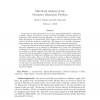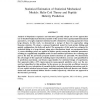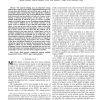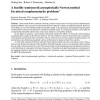957 search results - page 141 / 192 » From Margin to Sparsity |
CORR
2010
Springer
13 years 7 months ago
2010
Springer
Image data are often composed of two or more geometrically distinct constituents; in galaxy catalogs, for instance, one sees a mixture of pointlike structures (galaxy supercluster...
JCB
2007
13 years 7 months ago
2007
Analysis of biopolymer sequences and structures generally adopts one of two approaches: use of detailed biophysical theoretical models of the system with experimentally-determined...
TSP
2008
13 years 7 months ago
2008
The rapid developing area of compressed sensing suggests that a sparse vector lying in a high dimensional space can be accurately and efficiently recovered from only a small set of...
JSAC
2007
13 years 7 months ago
2007
— A Vehicular Ad Hoc Network (VANET) may exhibit a bipolar behavior, i.e., the network can either be fully connected or sparsely connected depending on the time of day or on the ...
MP
2002
13 years 7 months ago
2002
Semismooth Newton methods constitute a major research area for solving mixed complementarity problems (MCPs). Early research on semismooth Newton methods is mainly on infeasible me...




